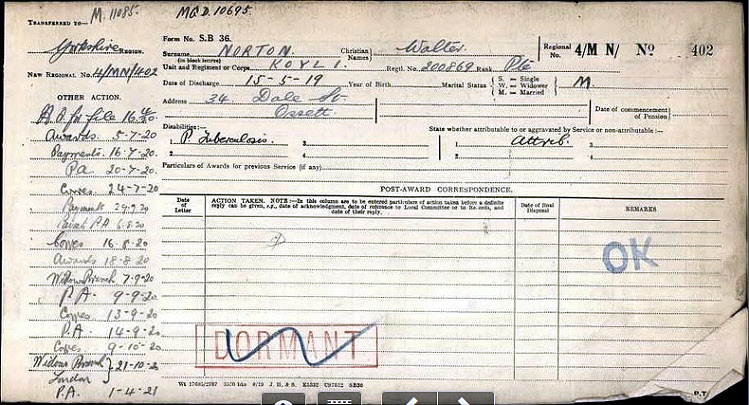
Walter Norton was born in Mirfield in 1893, the youngest child of four surviving children born to Frank Norton and his wife Lavinia who married in 1880. The couple had seven children from their marriage, but three children had died before April 1911.
In 1901 the family were living on Intake Lane, Ossett where Frank, of Pollington, near Snaith, was working as a coachman. The children had been born in several locations including Wigginton, York, Manchester, Denby Dale and Mirfield before the family settled in Ossett in the mid 1890s.
In 1911 Frank Norton, a gardener, his wife Lavinia and their daughter and three sons were living at Sunnydale Terrace, Ossett. Walter Norton, then aged 18 was a groom and horseman.
On the 18th January 1913 at Holy Trinity Church, Ossett, Walter Norton a 22 year old teamer of Sunnydale Terrace married 24 year old Ada Glover of New Street, Ossett. The couple subsequently moved to 34 Dale Street. They appear not to have had any children.
Then, on 4th August 1914, Germany invaded Belgium and Great Britain declared war on the German Empire. Walter’s Army Service record has not survived but it is known that he served with the Territorial 2/4th Kings Own Yorkshire Light Infantry Regiment.
The 2nd/4th Battalion of the King’s Own Yorkshire Light Infantry was formed at Wakefield on the 30th September 1914 as a second line unit. On the 1st March 1915 they moved to Bulwell and were attached to 187th Brigade in 62nd (2nd West Riding) Division. The Battalion moved in April 1915 to Strensall, York and on in May moved to Beverley, going on in November to Gateshead, in January 1916 to Larkhill and then in June 1916 to Flixton Park near Bungay. They moved again in October 1916 to Wellingborough and crossed from Southampton landing at Le Havre on the 15th January 1917.
It is also known that after the war ended Walter was awarded the British and the Victory medal in recognition for his service overseas in a theatre of war. He did not qualify for the 1914-15 Star indicating that he did not serve overseas until 1916 or later. His six digit service number, 200869, also suggests that this was allocated to him in early 1917 and so it seems likely that he embarked for France with his battalion on 15th January 1917.
This being the case Walter would have seen intense action including at Arras in 1917 and 1918, Cambrai in 1917, the later stages of the Somme and the final advance on Picardy in 1918. Walter’s elder brother, Frederick Flowers Norton, of Sunnydale Terrace, a gardener like his father, died on the 18th December 1917. He was 31 years of age.
On 9th November 1918 the 62nd Division , of which 2/4th KOYLI was a part, entered the southern outskirts of Maubeuge, crossed the Sambre and reached the Maubeuge-Avesnes road. The Division was selected to form part of the army which would advance across Belgium and occupy the Rhine bridgeheads; the only Territorial formation to receive this honour. The move began on 18 November, although the Division halted 1 – 9 December between Ciney and Rochefort. The German border was crossed on 15 December and the last units reached the allotted area around Schleiden on Christmas Day.
Walter was not discharged from service until 15th May 1919 some six months after the Armistice was signed on the 11th November 1918. By early July 1920 he had developed pulmonary tuberculosis which, it was acknowledged, was attributable to his service.

Above: Walter Norton’s WW1 Pension Card.
Walter Norton’s name was included on the Commemoration Programme issued for the unveiling of the Ossett War Memorial on the 11th November 1928. His name is also included on the Ossett Holy Trinity Roll of Honour. On the 11th November 2018 his name, and those of his comrades of The Ossett Fallen , was unveiled by Ossett school children.
Walter Norton, aged 27 years, died in July 1920 and was buried on the 5th July 1920 at the Ossett (Holy Trinity) Churchyard, Church Street, Ossett.